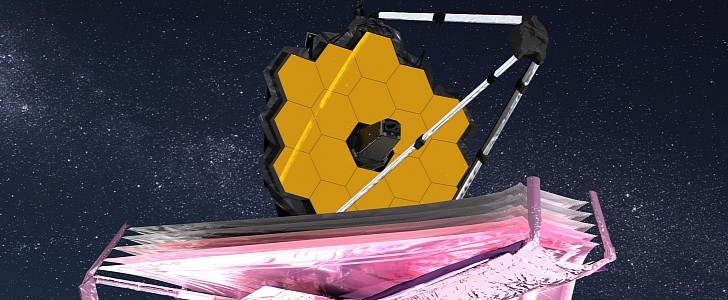NASA's James Webb Space Telescope is gearing up to peer into the first galaxies in the early universe. But in order to do that, the powerful telescope has to get super cold. Luckily, its final instrument has recently reached its operating temperature, staying just above absolute zero.
On April 7th, Webb's Mid-Infrared Instrument (MIRI) reached its optimal temperature. The instrument is capable of observing wavelengths longer than human eyes perceive in the mid-infrared region of the electromagnetic spectrum and operates at temperatures near absolute zero, or -447°F (-266.1°C).
The telescope has been slowly cooling ever since it reached its assigned orbit near L2, which is about one million miles (1,609,344 km) away from Earth. To look farther back in time, Webb will use all four instruments oboard that detect infrared light emitted by galaxies, stars, and planets.
Infrared light manifests as heat and because Webb's own electronics and optics hardware generate heat as well, cooling down the instruments suppresses infrared emissions. The MIRI detects longer infrared wavelengths than the other instruments, so it needs to be extremely chill.
These past months, MIRI slowly cooled to -298°F (-183°C) in the shade of the telescope's massive sunshield. However, making the temperature drop to near absolute zero needed some help from an electrically powered cryocooler. The challenge that scientists at NASA's Jet Propulsion Laboratory (JPL) had to face last week was the "pinch point," a critical point that occurs when the instrument's temperature drops from -433°F (-258°C) to -448°F (-266°C).
"The MIRI cooler team has poured a lot of hard work into developing the procedure for the pinch point," said Analyn Schneider, project manager for MIRI at NASA's JPL. "The team was both excited and nervous going into the critical activity. In the end it was a textbook execution of the procedure, and the cooler performance is even better than expected."
With everything operational and in good shape, the telescope will start taking several images of stars and other celestial objects, which will be used for calibration and to verify the instruments' performance. The first science images are expected to be delivered by Webb this summer.
The telescope has been slowly cooling ever since it reached its assigned orbit near L2, which is about one million miles (1,609,344 km) away from Earth. To look farther back in time, Webb will use all four instruments oboard that detect infrared light emitted by galaxies, stars, and planets.
Infrared light manifests as heat and because Webb's own electronics and optics hardware generate heat as well, cooling down the instruments suppresses infrared emissions. The MIRI detects longer infrared wavelengths than the other instruments, so it needs to be extremely chill.
These past months, MIRI slowly cooled to -298°F (-183°C) in the shade of the telescope's massive sunshield. However, making the temperature drop to near absolute zero needed some help from an electrically powered cryocooler. The challenge that scientists at NASA's Jet Propulsion Laboratory (JPL) had to face last week was the "pinch point," a critical point that occurs when the instrument's temperature drops from -433°F (-258°C) to -448°F (-266°C).
"The MIRI cooler team has poured a lot of hard work into developing the procedure for the pinch point," said Analyn Schneider, project manager for MIRI at NASA's JPL. "The team was both excited and nervous going into the critical activity. In the end it was a textbook execution of the procedure, and the cooler performance is even better than expected."
With everything operational and in good shape, the telescope will start taking several images of stars and other celestial objects, which will be used for calibration and to verify the instruments' performance. The first science images are expected to be delivered by Webb this summer.







